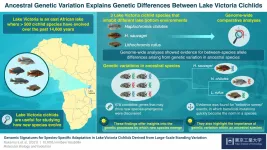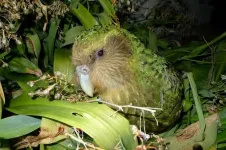Research on Lake Victoria cichlids uncovers the processes of rapid species adaptation
2021-04-28
(Press-News.org) Biologists use the term adaptive radiation to describe a phenomenon in which new species rapidly evolve from an ancestral species, often in response to changes in the local environment that lead to new biological niches becoming available. To understand this process, biologists often turn to the cichlids of Lake Victoria, in which over 500 species of the fish have evolved over the past 14,600 years. As Professor Masato Nikaido of Tokyo Tech explains, "The level of genetic differentiation among species is considered very low due to the short period of time after these different species began evolving, and this limited genetic differentiation provides us with a great opportunity to find candidate genes that have contributed to adaptive radiation and the evolution of new species."
Past studies on Lake Victoria cichlids have shown that species living at different depths in the lake differ considerably with respect to the alleles for a gene that determines visual abilities. Spurred by this evidence, Professor Nikaido and his colleagues, including scientists from the Tanzania Fisheries Research Institute, wanted to learn more about the genetic processes underlying adaptation to different environmental conditions. They therefore analyzed the genomes of three species of Lake Victoria cichlids: Haplochromis chilotes and H. sauvagei, which inhabit only rocky shores, and Lithochromis rufus, which inhabits diverse lake-bottom environments, including rocky and sandy areas and areas with vegetation. Their findings are soon to appear in Molecular Biology and Evolution.
Comparisons of genomic data from these different species led to the identification of 678 different genes located within genomic regions that exhibited considerable between-species variation. The researchers saw these genes as potentially playing critical roles in adaptive radiation, and they identified 43 that were specific to H. chilotes, 54 that were specific to H. sauvagei, and 63 that were specific to L. rufus. Some of these genes were related to behavioral variables, such as circadian rhythms, locomotion, and the development of sensory systems.
The genomic analyses also revealed signs of what biologists call "selective sweep events", in which selective pressures cause a beneficial mutation to rapidly increase its frequency within a population and become present in all members of a species. Furthermore, many of the species-specific alleles appeared to have existed alongside several alternative alleles prior to the adaptive radiation that produced different species of fish.
In conclusion, these analyses of Lake Victoria cichlids offer novel insights into the genetic processes underlying adaptive radiation. As Professor Nikaido puts it, "Our analyses uncovered the processes of species-specific adaption of Lake Victoria cichlids and the complexity of the genomic substrate that facilitated this adaptation."
The evidence for species-specific genetic alleles being derived from preexisting genetic variation is a particularly interesting finding that may prove useful to biologists who wish to understand adaptive radiation processes in different environments.
INFORMATION:
[Attachments] See images for this press release:

ELSE PRESS RELEASES FROM THIS DATE:
2021-04-28
Predatory bacteria--bacteria that eat other bacteria--grow faster and consume more resources than non-predators in the same soil, according to a new study out this week from Northern Arizona University. These active predators, which use wolfpack-like behavior, enzymes, and cytoskeletal 'fangs' to hunt and feast on other bacteria, wield important power in determining where soil nutrients go. The results of the study, published in the journal mBio this week, show predation is an important dynamic in the wild microbial realm, and suggest that these predators play an outsized role in how elements are stored in or released from soil.
Like every other life form on earth, bacteria belong to intricate food webs in which organisms are connected ...
2021-04-28
Constantina Theofanopoulou wanted to study oxytocin. Her graduate work had focused on how the hormone influences human speech development, and now she was preparing to use those findings to investigate how songbirds learn to sing. The problem was that birds do not have oxytocin. Or so she was told.
"Everywhere that I looked in the genome," she says, "I was unable to find a gene called oxytocin in birds."
Theofanopoulou eventually came across mesotocin, the analogue for oxytocin in birds, reptiles, and amphibians. But as she plumped the literature in Erich Jarvis's lab at Rockefeller, the waters grew muddier. If she and Jarvis wanted to find studies on oxytocin in fish, they ...
2021-04-28
Researchers from Erasmus School of Economics, IESE Business School, and New York University published a new paper in the Journal of Marketing that examines what business schools do wrong when conducting academic research and what changes they can make so that research contributes to improving society.
The study, forthcoming in the Journal of Marketing, is titled "Faculty Research Incentives and Business School Health: A New Perspective from and for Marketing" and is authored by Stefan Stremersch, Russell Winer, and Nuno Camacho.
In February 2020, an article in ...
2021-04-28
The flightless kakapo of New Zealand is in trouble. The world's heaviest parrot--representing one of the most ancestral branches of the parrot family tree--is nearly extinct, with barely 200 adults plodding the underbrush of four small islands. Whether the last of the kakapos had the genetic resilience to survive was a question that only high-quality genomic analysis could answer.
But a high-quality genome assembly did not exist for the kakapo--nor for most of the 70,000 vertebrate species alive today.
Questions about how best to prevent the extinction of species ranging ...
2021-04-28
ROCHESTER, Minn. -- Difficult-to-treat, chronic wounds in preclinical models healed with normal scar-free skin after treatment with an acellular product discovered at Mayo Clinic. Derived from platelets, the purified exosomal product, known as PEP, was used to deliver healing messages into cells of preclinical animal models of ischemic wounds. The Mayo Clinic research team documented restoration of skin integrity, hair follicles, sweat glands, skin oils and normal hydration.
Ischemic wounds occur when arteries are clogged or blocked, preventing important nutrients and oxygen from reaching the skin to drive repair. This groundbreaking study titled, "TGF-β Donor Exosome Accelerates Ischemic ...
2021-04-28
To be more energy efficient, many people have replaced their incandescent lights with light-emitting diode (LED) bulbs. However, those currently on the market emit a lot of blue light, which has been linked to eye troubles and sleep disturbances. Now, researchers reporting in ACS Applied Materials & Interfaces have developed a prototype LED that reduces -- instead of masks -- the blue component, while also making colors appear just as they do in natural sunlight.
LED light bulbs are popular because of their low energy consumption, long lifespan and ability to turn on and off quickly. Inside the bulb, an LED chip converts electrical current into high-energy light, including invisible ultraviolet (UV), violet ...
2021-04-28
The highly infectious SARS-CoV-2 variant that recently emerged in South Africa, known as B.1.351, has scientists wondering how existing COVID-19 vaccines and therapies can be improved to ensure strong protection. Now, researchers reporting in ACS' Journal of Medicinal Chemistry have used computer modeling to reveal that one of the three mutations that make variant B.1.351 different from the original SARS-CoV-2 reduces the virus' binding to human cells -- but potentially allows it to escape some antibodies.
Since the original SARS-CoV-2 was first detected in late 2019, several new variants have emerged, including ones from the U.K., South Africa and Brazil. Because the new variants appear to be more highly ...
2021-04-28
Uncapped, idle oil wells could be leaking millions of kilograms of methane each year into the atmosphere and surface water, according to a study by the University of Cincinnati.
Amy Townsend-Small, an associate professor of geology and geography in UC's College of Arts and Sciences, studied 37 wells on private property in the Permian Basin of Texas, the largest oil production region on Earth. She found that seven had methane emissions of as much as 132 grams per hour. The average rate was 6.2 grams per hour.
"Some of them were leaking a lot. Most of them were leaking a little or not at all, which is a ...
2021-04-28
April 28, 2021 -- Using naturalistic driving data and machine learning techniques, researchers at Columbia University Mailman School of Public Health and Columbia's Fu Foundation School of Engineering and Applied Science have developed highly accurate algorithms for detecting mild cognitive impairment and dementia in older drivers. Naturalistic driving data refer to data captured through in-vehicle recording devices or other technologies in the real-world setting. These data could be processed to measure driving exposure, space and performance in great detail. The findings are published in the journal Geriatrics.
The researchers developed random forests models, a statistical technique ...
2021-04-28
People of color, those with a higher income and younger individuals are more likely to participate in clinical trials during their cancer treatment according to a new study from the University of Missouri School of Medicine.
Clinical trials are research studies that involve people who volunteer to take part in tests of new drugs, current approved drugs for a new purpose or medical devices.
The study analyzed data collected from the Centers for Disease Control and Prevention (CDC) Behavioral Risk Factor Surveillance System Survey, which is an annual national telephone survey designed to collect health-related data from U.S. adults. Survey years selected included the question, "Did you participate in a clinical trial ...
LAST 30 PRESS RELEASES:
[Press-News.org] Research on Lake Victoria cichlids uncovers the processes of rapid species adaptation



